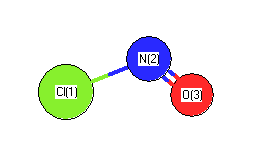Vibrational Frequencies calculated at B2PLYP=FULLultrafine/TZVP
| Mode Number |
Symmetry |
Frequency
(cm-1) |
Scaled Frequency
(cm-1) |
IR Intensities
(km mol-1) |
Raman Act
(Å4/u) |
Dep P |
Dep U |
|---|
| 1 |
A' |
1869 |
1869 |
581.95 |
11.58 |
0.26 |
0.41 |
| 2 |
A' |
601 |
601 |
106.15 |
3.27 |
0.43 |
0.60 |
| 3 |
A' |
328 |
328 |
71.23 |
17.81 |
0.39 |
0.56 |
Unscaled Zero Point Vibrational Energy (zpe) 1398.8 cm
-1
Scaled (by 1) Zero Point Vibrational Energy (zpe) 1398.8 cm
-1
See section
III.C.1 List or set vibrational scaling factors
to change the scale factors used here.
See section
III.C.2
Calculate a vibrational scaling factor for a given set of molecules
to determine the least squares best scaling factor.
